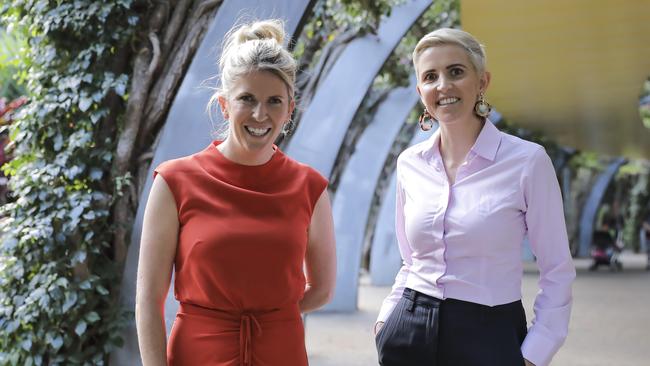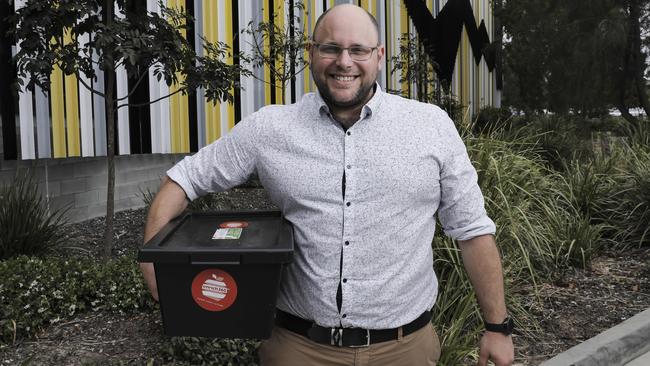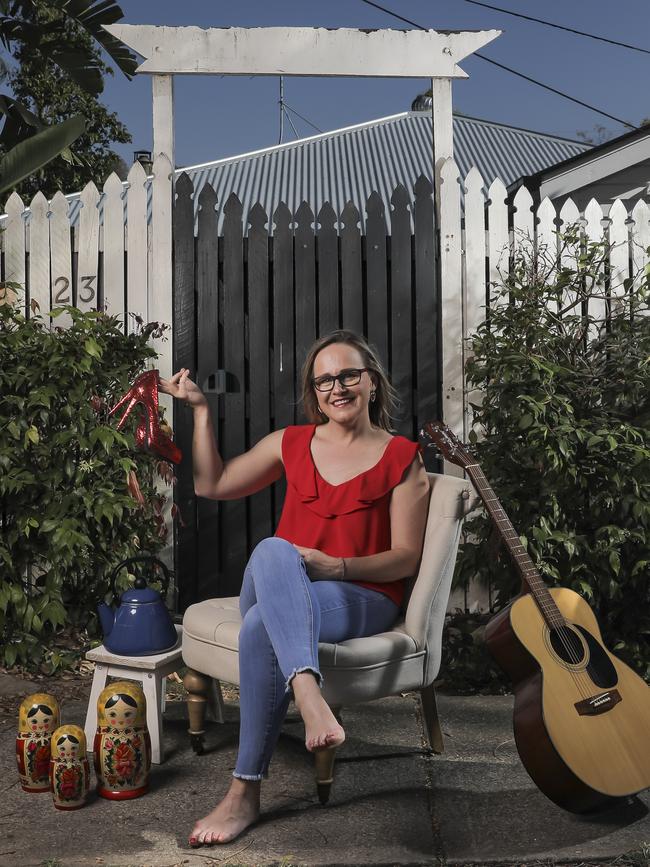Circular economy proves to be a boost for the bottom line
The days of a traditional economy may be numbered as a new idea takes hold. Big businesses like Rio Tinto, Lendlease and Brisbane Airport are all on board the revolution, are you?
QBM
Don't miss out on the headlines from QBM. Followed categories will be added to My News.
From new housing blocks in Logan to Rio Tinto’s smelter in Gladstone, there is an experiment under way. The same experiment is playing out in a pop-up designer shoe shop in Queen St and among the food halls of the Brisbane Airport.
Test subjects are consumers but also big businesses who are dipping their toes into what’s being called the circular economy (CE).
Such is the rise of the concept that investment behemoth BlackRock announced $US20 million seed funding for a CE-themed fund last month.
CE is a departure from a linear model of taking a resource, making a product, then discarding it after use. It sees waste as opportunity and products as a service.
Indeed, a perfect circular economy has no waste. And there lies the huge potential for value.
Among world leaders in CE are Queensland sisters Jaine and Ashleigh Morris.

Their company Coreo was invited to this year’s CE event at the UN General Assembly in New York. But the duo began almost by accident when they decided to run CE across an entire street on the Sunshine Coast in 2017.
The project is now an international prototype and Coreo – now based in the Brisbane CBD – is being called upon to work with top companies and governments here and overseas.
Jaine Morris says in the early days it was common for CE to be mistaken as a term for a fancy version of recycling.
“These are commercially viable solutions. These aren’t just environmentally nice things to do. These things make business sense,” she says.
“The World Economic Forum says CE could be worth $26 billion to the Australian economy by 2025.”
Reinventing the kitchen
One of Coreo’s clients is property giant Lendlease, which is developing the 2000ha Yarrabilba community in Logan that will be home to 50,000 people over the next 25 years.
It may also soon be home to one of the key CE foundations – products as a service – via an idea being investigated by Lendlease called “kitchens as a subscription”.
For $2 a week, home owners would get Fisher & Paykel’s most energy-efficient kitchen and laundry appliances with maintenance covered as well as replacement at the end when old machines would be reused or parts repurposed.
“Ownership stays with Fisher & Paykel which incentivises it to put up higher quality appliances with longer lifespans and for Lendlease it’s an attractive value add they can differentiate themselves with to the market,” Jaine explains.
“Yarrabilba is a slightly lower socio-economic market so it also allows home owners access to these products that will give them lower operating costs.”

For Lendlease it is just one part of its CE plan for Yarrabilba – which it thinks is the first master planned community in Australia to have one.
What trials end up moving forward will depend on results but Lendlease senior development manager Rob Ball says the Yarrabilba project has economies of scale and long time frames perfect for bold CE collaborations with the likes of Fisher & Paykel.
“Kitchen as a subscription doesn’t exist anywhere at the moment.We can provide that economy of scale to people like Fisher & Paykel to say this has legs, this has real benefits,” he says.
Business case
Coreo CEO Ashleigh Morris argues it won’t be solely up to consumers to decide if they buy in to the CE experiment because business will do it for them as they chase a competitive edge. She names Rio Tinto as running some of the most advanced CE projects, although what she can say about them is restricted by confidentiality. One example that can be mentioned involves Rio reprocessing about 1.5 billion aluminium cans a year in its Gladstone smelter in lieu of using virgin bauxite material to make its products.
“The cost of energy for Rio Tinto is about 40 per cent of its costs at the moment. By using recycled aluminium in their processes instead of virgin material they have an energy saving of 95 per cent so it makes massive commercial sense for Rio Tinto to use the recycled content,” Jaine says.
Rio’s copper supply chain is next to get the CE treatment. Brisbane City Council too is in confidential discussions with Coreo.

Another corporate eyeing the CE benefit to the bottom line is Brisbane Airport Corporation.
Tucked away in a basement of its Skygate precinct is a big metal machine that BAC environment and sustainability adviser Andrew Masci is very excited about. Over the past 10 months, Masci has been running a trial on the feasibility and commercial outcomes of turning all the food and beverage scraps from the shops into powerful fertiliser via the hulking stainless steel machine aptly called Enrich360. No other airport in Australia is doing it, he says, although Ikea in Melbourne now has the machine too.
In about 10 hours it converts food “waste” including bio cutlery into fertiliser which for now is being trucked to the Brisbane markets (in trucks that were already coming to the precinct to deliver food) and sold to a composting business at Yatala.

The long-term goal, however, is to sell or donate the fertiliser to farmers and then buy back produce grown by that farmer. To make that commercially viable Masci needs more waste and fertiliser and his trial will determine what path BAC takes with the project.
“The justification is cutting our costs, such as landfill fees,” he says.
He is also looking for revenue stream for other things like cardboard or glass bottles.
However, Masci’s most ambitious goal involves major stakeholders like airlines and, most importantly, consumers who would have to let go of their beloved disposable coffee cups and see it as a service.
Coffee would be served in reusable cups with buyers refunded a fee when they return the cups to bins placed throughout the airport. Perhaps the cups could even be made from the hundreds of thousands of plastic bottle lids BAC currently collects and is looking for a way to use.
“The biggest thing is going to be educating people,” Masci says.
Trash to treasure
During late night shopping in the Queen St Mall, Yasmin Grigaliunas’ team are educating people about CE via designer shoes. Grigaliunas, founder of the World’s Biggest Garage Sale startup, has secured a deal to take over an empty shop in The Wintergarden and fill it with thousands of shoes once doomed to sit in storage.
Volunteers explain to shoppers the shoes they are buying for $49 were all left behind when bespoke maker Shoes of Prey collapsed. Profits from the pop up, which runs until mid-November, are going to charity.
Grigaliunas is working with councils to license her model, which activates unwanted goods and gets them back into the economy, with at least 50 per cent of profits always given back to community or charity.

“That’s our end game – to transform the secondhand economy to be a circular economy. So shoes that are sitting in warehouses for two or three years will be brought back into the economy in a beautiful retail space,” she says.
“At state and federal level now there is circular economy conversation. It’s happening in Canberra, it’s happening across the country, but for it to happen faster it takes companies like us and others to be involved because (governments) are too slow.”
The speed at which CE is being implemented is interesting, says Queensland Chief Entrepreneur Leanne Kemp. She says compared to the likes of Taiwan, where repurposing has existed for 25 years, Australia is lagging but we are on a par with the UK.
She also points to industries like jewellery that have always practised CE because of the high value of “waste” such as tiny filings of gold left behind when rings are made that are sucked up via specialised vacuums.
“We have been searching for a profit-and-loss reason as to why we need to do this and ultimately we are creatures of commerce. But at every single place I was in the world (recently), large global stages are recognising CE is not a catch phrase, it’s becoming completely embedded in economic policy,” she says.


